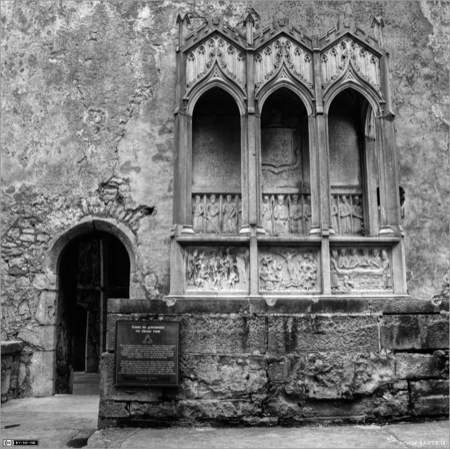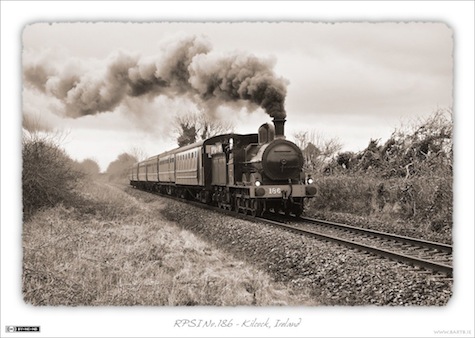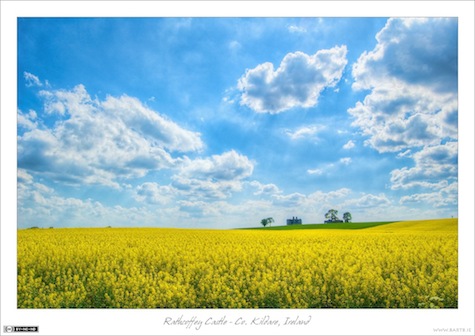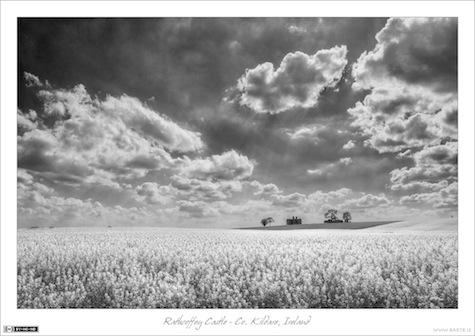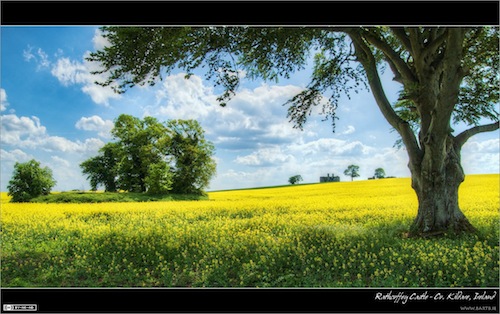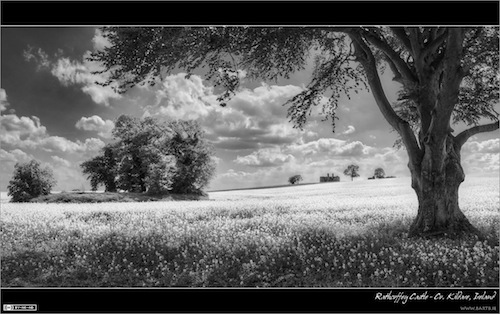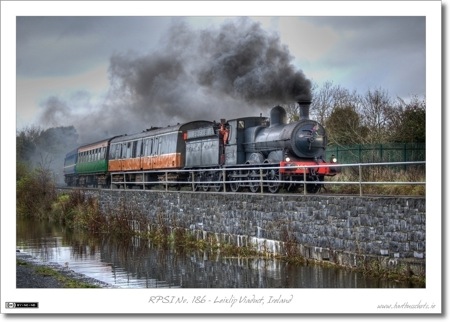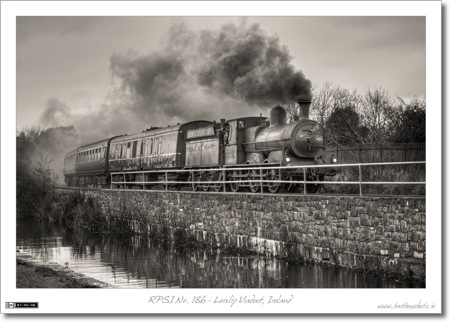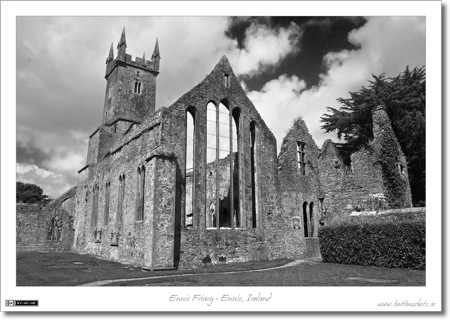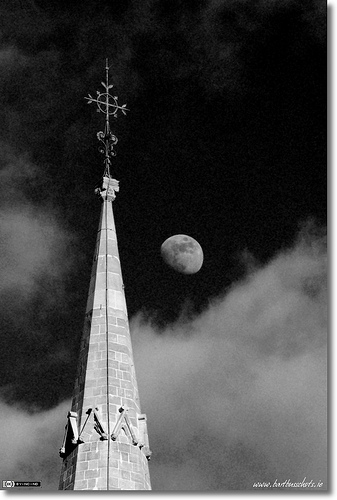Feb
14
Photo of the Week 157 – Ennis Friary
Filed Under Photography on February 14, 2011 | Leave a Comment
This is another one of the shots I took in the ruins of Ennis Friary when I visited Ennis for a friend’s wedding the summer before last. This is not the first shot from that visit to make my Photo of the Week series, see also Photo of the Week 77, Photo of the Week 87 & Photo of the Week 153. I chose to process this shot as a monochrome HDR to really bring out the fantastic textures in this tomb and the doorway next to it.
- Camera: Nikon D40
- Lens: Nikon DX AFS 18-55mm (D40 kit lens)
- Exposure: 1/125 sec
- Focal Length: 18mm
- Focal Ratio: f/8
- ISO: 400
- Camera Mode: Aperture Priority
- Processing: created by tonemapping a single RAW image with Photomatix Pro, then converting it to monochrome with the Channel Mixer brick in Aperture, and bringing out the texture even more using the Curves brick.
Aug
9
Photo of the Week 129 – No. 186 Steaming West
Filed Under Photography on August 9, 2010 | 1 Comment
Since it’s been a while since I posted a railway shot in this Photo of the Week series, I thought I’d treat myself by posting my favourite steam shot of the year (so far). I chose this location precisely because it’s free from modern distractions. There are no modern houses, no electricity pylons, no modern signals, no modern electronics cabinets, in short, nothing to break the illusion of timelessness. OK – that’s not entirely true. Those of you with a very keen eye will notice the one unavoidable piece of modernity in this shot – the track itself – it’s continuous welded rail on concrete sleepers. You can rest assured that when No.186 was earning it’s keep for the Great Southern & Western Railway it wasn’t running on anything nearly as fancy, smooth, or comfortable! Still – very few people will find the modern track-work a distraction from the timeless beauty of a steam engine hard at work.
For those of you interested in such details, this is RPSI preserved steam loco number 186. She’s a class J15 0-6-0 former GS&WR loco, manufactured in Manchester in 1879, and retained in service until 1964. Here we see her on a cold, windy, and rather damp Easter Monday morning near Kilcock Co. Kildare, working the Easter Egg-spress from Dublin to Mullingar.
- Camera: Nikon D40
- Lens: Nikon DX AFS 55-200mm
- Exposure: 1/640 sec
- Focal Length: 55mm
- Focal Ratio: f/5.6
- ISO: 800
- Camera Mode: Full Manual
- Processing: This shot was first tweaked using the Topaz Adjust plugin in Photoshop Elements 8, then converted to monochrome using the Monochrome Mixer in aperture, and then give a subtle sepia tone using the Colour Monochrome brick in Aperture.
Aug
2
Photo of the Week 127 & 128 – Big Summer Skies
Filed Under Photography on August 2, 2010 | Leave a Comment
I’ve been on a bit of a break from Photography – a combination of injury and crap-tacular weather, so I have yet another catch-up post to do! As always when I do multiple posts, the two images are related, in this case, very related, being two different treatments of the same RAW image. This shot was taken on the same day as the last monochrome-colour combo I posted (Photo of the Week 111 & 112 – Summer in Rathcoffey), and from a spot only a few hundred feet from where that last shot was taken.
Yesterday I posted some of my thoughts on Photographic composition, and used that post as the basis for a conversation with Allison on episode 271 of the Nosillacast podcast. In that discussion we talked about the importance of getting layers into photographs of places to give a sense of depth, and in particular we talked about the importance of the foreground layer. As part of that discussion I drew attention to the fact that there are a huge amount of possible foregrounds for every background. You can usually move hundreds of feet without making much, if any, change to the background when you’ve shooting landscapes. This gives you a wide menu of foregrounds to choose from.
If you compare and contrast these photos with those from my Photo of the Week 111 & 112 post, you’ll get a good example of just how different a shot you can get by just changing the foreground. Both sets of photos have Rathcoffey Castle as the background, both have the field of flowering Rape Seed flowers as the mid-ground, and both have the same dramatic sky at the top of the frame, but both have very different foregrounds, framings, and compositions, resulting very different photographs.
These shots have a far simpler composition, with far fewer elements in the frame. It really is just the field, the castle, and the sky. The previous shot was about showing the many interesting things around the edges of the field, the beautiful old tree, the ancient Ring Fort, and of course the castle, so it was composed in such a way as to show all these things without cluttering the frame. The filed and the sky were in that shot too, but they were almost incidental. Here, we have much less in the frame, so both the sky and the big sweeping field are the stars of the show, with the castle adding some nice interest to the background, but not being the star of the show.
These two sets of shots were taken very close to each other. The first a little to the left of the Ring Fort, with the Ring Fort included, the other a little to the right of the Ring Fort with it excluded. The Ring Fort is literally just a few pixels off to the right of this shot, but because you don’t see it, you assume it’s not there, and that the field goes on for ever. As it happens it really is a very big field, but doesn’t come across half as well in the shot if you include it’s edges.
As with the previous photos, this pair was generated using the workflow I described on the Typical Shutterbug Podcast.
- Camera: Nikon D40
- Lens: Nikon DX AFS 18-55mm (D40 kit lens)
- Exposure: 1/1250 sec
- Focal Length: 18mm
- Focal Ratio: f/8
- ISO: 200
- Camera Mode: Aperture Priority
- Processing: single RAW image first tonemapped with Photomatix Pro, then tweaked with the Topaz Adjust 4 plugin in Photoshop Elements
- Camera: Nikon D40
- Lens: Nikon DX AFS 18-55mm (D40 kit lens)
- Exposure: 1/1250 sec
- Focal Length: 18mm
- Focal Ratio: f/8
- ISO: 200
- Camera Mode: Aperture Priority
- Processing: single RAW image first tonemapped with Photomatix Pro, then tweaked with the Topaz Adjust 4 plugin in Photoshop Elements, and finally converted to monochrome using the Channel Mixer in Apeture
Jun
27
Photo of the Week 122 & 123 – Summer in Rathcoffey
Filed Under Photography on June 27, 2010 | 5 Comments
Last weekend the weather was just too good to sit inside working on a computer, so I didn’t find the time to post a photo of the week. This means we’re playing catch-up today with a double posting. As usual for a multiple post, I’ve chosen a theme to link the shots, in this case, both were generated from the same original RAW image from the camera!
Both shots show a wonderful view taken from a back road near Maynooth in Co. Kildare Ireland. The road is at the bottom of a sweeping hill at the top of which stand the ruins of Rathcoffey Castle. The farmer grows Rape Seed on the hill, so when that crop is in bloom, you get this amazing scene where the whole field is bright yellow, truly spectacular!
The fist shot I’m posting is the colour version, this is a panoramic crop, and was generated from a single RAW file by first tonemapping it with Photomatix Pro, and then tweaking the resulting image a little using the Topaz Adjust 4 plugin in Photoshop Elements. You might ask why the image needed to be tonemapped? The simple answer is that the difference in brightness between the land and sky were just too great to properly expose both in a single traditional exposure. Exposing either correctly would result in the other being badly under or over exposed. Tonemapping allows both to be properly exposed at the same time.
- Camera: Nikon D40
- Lens: Nikon DX AFS 18-55mm (D40 kit lens)
- Exposure: 1/800 sec
- Focal Length: 18mm
- Focal Ratio: f/8
- ISO: 200
- Camera Mode: Aperture Priority
The second shot was generating by using the first as a starting point, and then using the channel mixer to generate a monochrome version. The channel mixer allows you to choose how much of each colour goes into the black & white version of the image. By turning down the blue channel you can get stunning black skies which make for really dramatic photos.
- Camera: Nikon D40
- Lens: Nikon DX AFS 18-55mm (D40 kit lens)
- Exposure: 1/800 sec
- Focal Length: 18mm
- Focal Ratio: f/8
- ISO: 200
- Camera Mode: Aperture Priority
Nov
8
Photo of the Week 89 & 90 – Steam Loco No. 186
Filed Under Photography on November 8, 2009 | 4 Comments
Since I was ill last weekend I’m doing a double-post this weekend. In this case, it’s actually the same shot post-processed in two different ways.
Both shots are of the steam locomotive No. 186 which started it’s life as a mainline locomotive for Ireland’s Great Southern & Western Railway (GS&WR or just GSWR). No. 186 is now lovingly maintained by the Railway Preservation Society of Ireland (RPSI), and gets to stretch it’s legs on various Irish Rail mainlines on steam specials. This shot was taken when No. 186 was pulling the Ghost Train steam special from Dublin Connolly to Mullingar and back to Dublin Connolly. Here we see No. 186 crossing the Leixlip Viaduct on her way out to Mullingar in the morning. You can read more about No. 186 on the RPSI’s Website.
Normally when I tone-map shots I like to keep them looking natural, but in this case I really liked the result of pushing things a little further. The result is still quite natural, but yet also somewhat hyper-real.
The second version uses the first as the base for the conversion to monochrome. Because black and white shots tend to pick up a lot of texture anyway, the hyper-real look of the first version is completely lost in the second. We’re used to Sepia tone shots having this level of texture and detail in them.
You can see all my photos from this steam special in this Flickr Set.
- Camera: Nikon D40
- Lens: Nikon DX AFS 55-200mm
- Exposure: 1/320 sec
- Focal Length: 55mm
- Focal Ratio: f/4.5
- ISO: 400
- Camera Mode: Aperture Priority
- Processing (Version 1): Started by tonemapping a single RAW image in Photomatix Pro, then selectively tweaked the exposure, contrast, and saturation using the Dodge & Burn plugin in Aperture.
- Processing (Version 2): Took the veresion described above as the starting point, then converted to monochrome using the Channel Mixer brick in Apeture, then added a subtle Sepia Tone using the Colour Monochrome brick.
Oct
18
Photo of the Week 87 – Ennis Friary
Filed Under Photography on October 18, 2009 | 1 Comment
I don’t do many black & white conversions, but for some reason Ennis Friary seemed to lend itself to them very well. I guess old church buildings just work in monochrome! This week’s Photo of the Week is one from a set taken on the 1st of August this year when I was in Ennis for a friend’s wedding.
Wide angle lenses cause distortion which makes parallel lines not look parallel, this generally takes away from images of buildings. However, in this image the distortion actually adds to the shot because of the angle of the camera relative to the building. We’re not looking at the building face-on, but instead corner-on. The building is still distorted, but rather than being off-putting the distortion works to make the building look more imposing.
The easiest way to make a colour image black & white is to simply desaturate it. This almost never gives a nice image. The output tends to be bland, flat, and boring. If you want to get a better conversion you need to use a channel mixer. This allows you to control the levels of each colour that are used to create the final monochrome image. You can spend hours tweaking with the mixer, but when it works, it can give very striking images. In this case I used the mixer to take out the blue channel entirely, this turned the blue sky the dramatic black colour you see here. I also turned the green channel down a bit to darken the grass a little. Finally, the red channel was boosted to make up for the reduction in light from reducing both the blue and green channels. This had the effect of brightening the building relative to the grass and sky so it stands out.
- Camera: Nikon D40
- Lens: Nikon DX AFS 18-55mm (D40 kit lens)
- Exposure: 1/1250 sec
- Focal Length: 18mm
- Focal Ratio: f/8
- ISO: 400
- Camera Mode: Aperture Priority
- Exposure Bias: -0.3ev
- Processing: The image was converted to monochrome using the Channel Mixer, and then the contrast in the building was selectively increased using the Dodge & burn plugin in Aperture.
Jan
19
Photo of the Week 48 – Lunar Cross (Black & White)
Filed Under Photography on January 19, 2009 | 4 Comments
As you can probably guess by the list of previous photos of the week, I’m not really into black & white photography. However, I do dabble occasionally, and particularly enjoy playing with the channel mixer to get more dramatic and contrasty images. This is my favourite black & white conversion so far. This shot of the Moon over the top of the spire of the Gunne Chapel (AKA the College Chapel) on the St. Patrick’s College Campus (AKA NUI Maynooth South Campus) in Maynooth, Ireland. The black & white conversion was done using the channel mixer in the GIMP (a free cross-platform image editor). It was shot during the day, but made more dramatic by turning the blue channel right down to zero so the sky goes black.
- Camera: Nikon D40
- Lens: Nikon DX AFS 55-200mm
- Exposure: 1/250 sec
- Focal Length: 200mm
- Focal Ratio: F22
- ISO: 800
- Camera Mode: Aperture Priority
- Processing: Converted to black & white using the channel mixer in the GIMP







